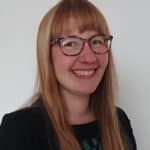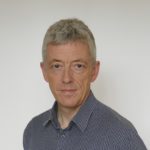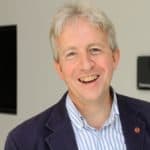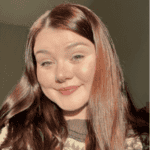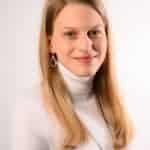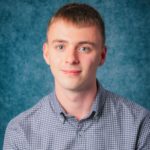Profile
Hayley Pincott
Associate Practitioner - I turn biopsies into slides so pathologists can help doctors diagnose and treat patients
-
About Me:
I have my hands full at home with 3 boys so any spare time I have I try to relax. I like to draw and read to relax.
-
Read more
I live in Cardiff with my husband and 3 boys. In my spare time (whenever I can grab a few minutes) I like to sketch and draw, I must stress though this does not mean I am any good though. A little something I did on my sons wall……
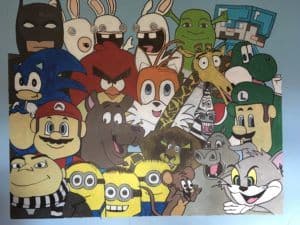
I also like to read I love Patricia Cornwel and her Kay Scarpetta series, all about a chief medical officer, they’re a bit of CSI, forensics and crime.
Most of my time is taken up with my 3 sons, as I work full time I try to spend quality time with them at the weekend (Just don’t look at the state of my house because of this). I take them to the park, they like to go to the castles we are lucky enough to live by, I’ve got one son who is dinosaur mad so the museum is always popular with him. My favourite time though is after dinner and we’re all sat on the sofa watching a good film under the blanket and eating lots of sweets, although I have to admit that the sweet eater is usually only me.
-
My Work:
I turn a biopsy into a slide to help consultants diagnose, treat and manage a patients condition.
-
Read more
I’ve been an Associate Practitioner Healthcare Scientist for jst over 4 years in Cellular Pathology. I started in University Hospital of Wales where I was for 2 years then due to childcare I had to leave my job and leave my degree to take care of my then young family. I was very fortunate to come across a post here in Oral Pathology at the University Dental Hospital where I’ve been for just over 2 and half years. I love it here and I love the people I work with. As it’s such a specialist lab I work with a Biomedical Scientist in Cellular Pathology and I work with a Biomedical Scientist in Microbiology, and after that it’s just 3 consultant pathologist. So just the 6 of us running a specialist service that covers South East Wales and the only one of it’s kind in Wales. I feel it’s something to be really pround to be a part of.
As it’s such a small specialist lab I’ve had the opportunity to attend theatre for the day, I’ve been to an MDT meeting, this is where all the specialists meet up to discuss patients and their diagnosis, and then they decide the next course of action and how to manage or treat the patient. I’ve been fortunate enough to have the opportunity to become a STEM ambassador and write a couple articles. I’m one very lucky worker.
I’d love to have the oppotunity to complete my degree so I can also become a Biomedical Scientist however it’s proving difficult so some of my time now is focused on being a STEM Ambassador. There will be a shortage of pathologists in a few years and as 70-80% of a patients diagnosis involve pathology then that’s quite a serious state of affairs so I try to showcase what we do in pathology when I organise these STEM visits as it’s something I really feel strongly about.
A few pics of what I’ve done…

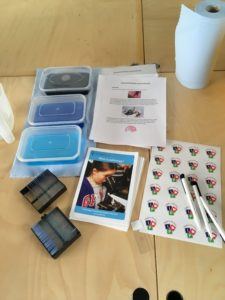
-
My Typical Day:
Through a number of processes in the lab I turn a biopsy into a slide to give to the pathologists so they can produce a report. This report goes to consultants who then use the report with resources like x-rays and scans to diagnose, manage or treat a patient.
-
Read more
Firstly we embed the biopsies that have come off the machine following overnight processing. Overnight processing is where free water is removed from tissue and replaced by wax, this is done by immersing the tissue in various solvents. First the tissue sits in formalin, this just fixes the tissue in a life like state so it doesn’t start to decompose. Then the tissue goes through alcohols this is because alcohol dehydrates things so it’s the alcohol that removes the free water. Next the tissue goes into xylene, this is because xylene is miscible with both alcohol and the wax which is the last step of tissue processing.
Embedding is where the tissue is put into a small mould and encased in wax, this is done so we can then cut it to produce slides, if you think about it we can have small biopsies that are only 1mm and then tissue processing can shrink tissue by a third so we need something substantial to “hold” the tissue.
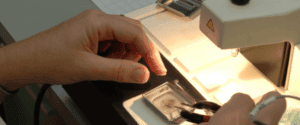
Next we cut really thin sections on a machine called a microtome. the sections are 4microns thin. There are 1000 microns in 1mm so we are dealing with really thin pieces of tissue (about a 10th thinner than a strand of hair). When we have cut a ribbon of tissue we float it on warm water this irons out any wrinkles that may appear in the wax section we have just cut and also it makes the section easier to pick up on a slide. When we have produced a section of tissue on a slide then it is ready to be stained.
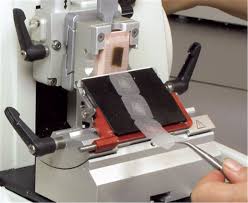
Our basic go to stain is H&E (Haematoxylin and Eosin), it produces a pink and purple section for the pathologists to look at under the microscope. The nucleus of a cell stains purple and the cytoplasm stains pink. Lastly we check patient details again before the cases go out to the pathologists. The pathologists can see if surgeons have taken enough tissue away in cancer cases to make sure they didn’t leave any behind, this is what we call clear margins. They also look at small biopsies like polyps and papillomas, there are some conditions that are a warning sign for cancer so the pathologists diagnose these and the clinic know to monitor that patients condition to make sure that if it does become malignant then we can act on it straight away and be able to provide a good prognosis.
The last thing we do in the day is specimen dissection where the pathologists will describe the biopsy and take representative pieces to the process over night and it’s these biopsies that will be embedded in the morning and the cycle starts over again. But no two days are the same as we always see such a variety of cases.
-
What I'd do with the prize money:
As I can’t bring people into a pathology lab then I’ll take the lab to them. I’d use the money to develop workshops and resources related to anatomy and the lab to take into schools.
-
Education:
Ribston Hall High School 1990-1995,
Central Technology College 1995-1997,
UWIC 2010-2012
Edinburgh University 2020-2021
-
Qualifications:
8 GCSE’s (C-E)
Advanced GNVQ Science (merit)
HNC Biomedical Science (merit)
PGCert Science Communication & Public Engagement (pass)
-
Work History:
Cellular Pathology & Biochemistry Gloucester Royal Hospital
Specimen reception & Cellular Pathology University Hospital of Wales
Oral Pathology & Microbiology, University Dental Hospital
See Science
-
Current Job:
Associate Practitioner Healthcare Scientist
STEM Ambassador Programme Manager for Wales
-
My Interview
-
How would you describe yourself in 3 words?
inquisitive, fun, enthusiastic
What did you want to be after you left school?
Physiotherapist
Were you ever in trouble at school?
I was too scared to be a little bit mischievious
Who is your favourite singer or band?
At the moment listening to Dua Lipa (not sure if I'm too old though!!!)
What's your favourite food?
Easy......CHIPS!!!
If you had 3 wishes for yourself what would they be? - be honest!
To have a happy and healthy family, be respected in my career and I wish to own a pair of louboutin shoes
Tell us a joke.
How do you make an octopus laugh? give it ten tickles
-

